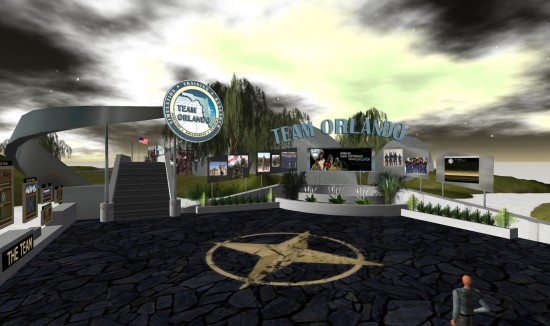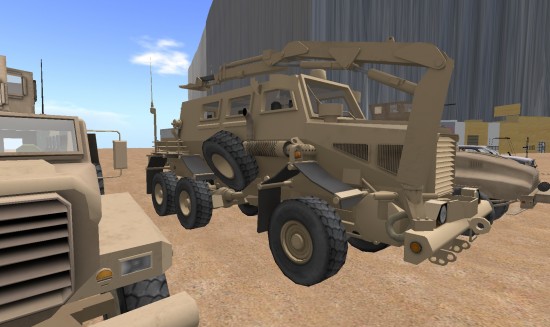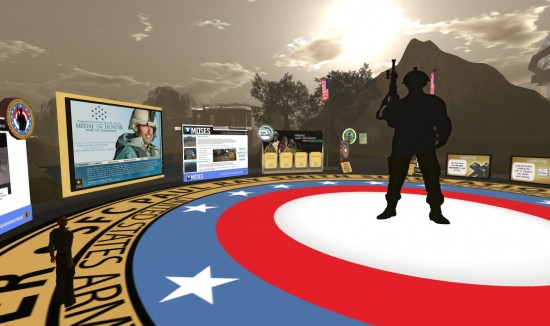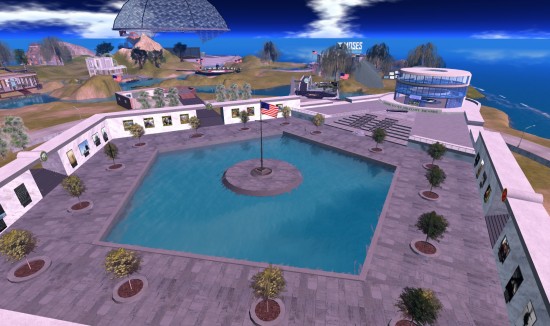The military’s MOSES project has achieved its performance goals of creating an OpenSim grid with Second Life-level or better features and stability. Â The team behind it has also reached out to other organizations with guidance and support.
The only goal remaining unfulfilled is that of securely linking to other grids, and the team is still working on it.

What is MOSES?
MOSES — which stands for Military Open Simulator Enterprise Strategy — is not just a private 200-region OpenSim grid, but is also a plan to evaluate OpenSim and its ability to provide network independent and secure access to a virtual environment. In addition, it is intended to be a best practice guide for other organizations wishing to deploy an OpenSim-based virtual world.
The grid of the same name was initially deployed in February of 2011 to a limited test group of about a dozen OpenSimulator expert users and it debuted to the public on March 22, 2011 at the Defense GameTech Users Conference in Orlando, Florida.  It was shown for the first time to a large public crowd at the tutorial, “Virtual Worlds:  Advanced Topics with Second Life – Programming & Managementâ€.  The advanced topic was a discussion of the MOSES project and the sane approaches to OpenSim migration with comparisons to both grids.

The OpenSim project is an initiative created to address issues such as content portability, security, and cost. Using this open source software, educators can explore the use of a Second Life-style environment without significant investment, use the environment in an enclave network environment to protect students that may be under age and have the ability to backup their work.
MOSES was founded with main goals:
- To meet or exceed the service and capabilities provided by the Second Life Enterprise product. That includes creating a persistent virtual world with a stable server environment with redundancy, voice communications, a basic content library, mesh-based content import, in-world multimedia presentation capability, an on-line graphical monitoring mechanisms to start and stop server processes remotely, and an online graphical user management and setup.
- To provide a stable and in-kind Second Life-like client environment.
- To provide guidance to other organizations wishing to replicate MOSES results.
- To link to other organizations to expand the MOSES grid.
The first three of these four major goals have already been achieved.

The MOSES sims reside on a cluster of five hardware servers utilizing 240 processors and 2.5 terabytes of available RAM. They are running on virtual machines and have uptimes measured in weeks, even with vigorous prim and script counts.
The MOSES team has an almost unhealthy obsession with stability and reliability on the grid. Early in the fall of 2012 the Mumble/Whisper modules were integrated successfully into the MOSES grid, giving independent access to voice over IP service. The Mumble servers are hosted concurrently with the MOSES servers. Almost all of the functionality found in Second Life is replicated in MOSES.
Leading by example
The best way to provide guidance to other organizations for deployment and maintenance was not to simply write another dry military technical report, but to lead by example.
To achieve this, the MOSES team has prepared “MOSES in a Box,” a project designed to replicate all aspects of the MOSES servers into a single virtual machine. Our choices for operating system, database deployment, and even the graphical management tools are included. Version 0.1.1 of the MIAB was released in September 2012, and is available to download for free, as long as people sign a distribution agreement. You can request your copy by emailing arl.sttc.open.simulator@us.army.mil.

This project has been well received and had been deployed to both Navy and Air Force sites. Other organizations have dissected and modified the MIAB to fit their environments, thus using it as a model for their own deployments.
The one goal the MOSES project has not yet achieved is the linkage of sims to other organizations. This is a policy and security issue, not a technical one.
Currently, the exposure of the databases is too risky and work is ongoing to address those issues. The MOSES team is currently working with the open source community, the Phoenix Firestorm team, and industry to explore the most appropriate ways to include enhanced security in OpenSim.
We are working on PKI [public key infrastructure] and CaC [common access card] authentication methods for logins as well as certificate level authentication for content. We are looking at end-to-end encryption strategies for all transactions between the clients and servers. We believe securing the grids will have the added benefit of encouraging more professional content developers to participate in the OpenSim grids.
The backstory
The US Army Research Laboratory Simulation and Training Technology Center (ARL-STTC) conducts research into gaming and virtual world technology for possible application to military training needs. The center tests and evaluates numerous virtual world technologies, from both industry and the open source community and it is widely recognized there is still no “one size fits all†solution for all the training and education needs of the military.
Some virtual environments excel at providing classroom focused experiences, other virtual worlds may have better terrain and weather capabilities, still other virtual technologies may have very high accuracy but low graphics quality. The sacrifices needed to support various capabilities are often fidelity in the simulation.
What is needed is a flexible virtual training framework that allows for variable fidelity depending on training objective.
One of the virtual worlds investigated was Second Life, an online three dimensional virtual world designed to allow for significant social interactivity. Content in Second Life is uploaded and presented by the users, called residents, and not created by Linden Lab, the makers of Second Life. This is a radical departure from the traditional art and content pipelines of traditional virtual environment based training systems in the military.
Objects in Second Life are interoperable and capable of being scripted to perform various behaviors. This allows for computational steering and represents a major shift from the traditional virtual training environment creation process.
These attributes also allow for subject matter experts to directly upload work and training material rather than be completely dependent on artists and modelers. These features are the basis of what could become a mission editing system that an educator or trainer could use, significantly reducing the amount of time and money needed to modify or create new training material.
Initial exploratory efforts by the US military in the Second Life product revealed a number of useful activities could be accomplished, not only for training but also modeling and simulation. For example, procedural training activities are accomplished through the creation of a virtual representation of a working environment. This allows participants to make mistakes safely and inexpensively.
Other great use cases include the preparation for rare or dangerous events. Another useful example is the creation of interactive situations that challenge the user and provide feedback for knowledge training.
The simple scripting language in Second Life allows for a non-determinant learning environment driven by objectives, not framework limitations.
Second Life has been established as a useful platform for educators and online learning. However, certain drawbacks to the platform have been exposed.
These drawbacks can be described in three broad categories: cost, control, and security.
Linden Lab has created a profit structure where they benefit from users adding to their framework. Specifically, the content in the platform is very difficult to export. Since Second Life makes provisions for all content to have intellectual property rights associated, work created in group settings can become difficult to establish ownership rights, making capture and backup a challenge.
Although it costs nothing for a casual user to register an account and enter Second Life, individuals or organizations who wish to create content need to purchase space to do so. Private space costs $1,000 setup fee with $295 per month in maintenance costs.
In addition, professional content services can easily become the most expensive part of creating any sim or estate, so the inability to backup or reuse the investment becomes problematic.
Since Second Life is a public forum, certain security and privacy issues arise.
Educators often feel the need to obtain this private space so that the students are protected from exposure to the rest of the Second Life citizens. Military users need to be able to operate the virtual training environments on networks separate from the Internet. Often times the training material is sensitive or simulation data has a classified component.
Since Linden Lab does not currently offer a version of the Second Life platform for use behind a corporate or government firewall, the product has limited utility.
Today, the MOSES grid has grown to almost 200 regions, with over 400 registered users. MOSES has dozens of estates with active educational and research activities.
MOSES has been copied and deployed to other government and academic networks. The feedback from the open source community, the users, and the community as a whole has allowed the MOSES to evolve into a stable and reliable standalone virtual world.
For more information, visit http://brokentablet.arl.army.mil/ or email arl.sttc.open.simulator@us.army.mil
- MOSES calls for new foundation to move OpenSim forward - September 27, 2016
- US military turns to Halcyon branch of OpenSim - August 16, 2016
- LIDAR accelerates virtual building - October 11, 2014
